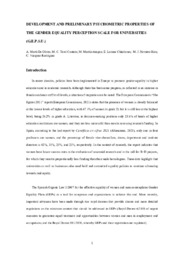Please use this identifier to cite or link to this item:
https://hdl.handle.net/11000/34925Full metadata record
| DC Field | Value | Language |
|---|---|---|
| dc.contributor.author | MARTÍ DE OLIVES, ANA | - |
| dc.contributor.author | Terol Cantero, M Carmen | - |
| dc.contributor.author | Martin-Aragón Gelabert, Maite | - |
| dc.contributor.author | Lozano Chiarlones, Elisa | - |
| dc.contributor.author | Navarro-Ríos, María Jesús | - |
| dc.contributor.author | Vázquez Rodríguez, Carolina | - |
| dc.date.accessioned | 2025-01-18T11:14:26Z | - |
| dc.date.available | 2025-01-18T11:14:26Z | - |
| dc.date.created | 2024-02 | - |
| dc.identifier.citation | High Educ Policy (2024) | es_ES |
| dc.identifier.issn | 1740-3863 | - |
| dc.identifier.issn | 0952-8733 | - |
| dc.identifier.uri | https://hdl.handle.net/11000/34925 | - |
| dc.description.abstract | In recent decades, policies have been implemented in Europe to promote gender equality in higher education and in academic research. The Spanish Organic Law 3/2007 for the efective equality of women and men contemplates Gender Equality Plans (GEPs) as a tool for companies and organizations, including universities, to achieve this end. One of the most relevant concerns in any GEP is the initial diagnosis of the situation, but the literature also points out a need for periodical monitoring of the state of inequalities to measure the impact, efects and consequences of the implemented actions of the plan. Hence, the aim of this article was to develop a questionnaire for equality as perceived by staf in a university labor context and to explore its preliminary psychometric properties. The GEPSU (Gender Equality Perception Scale for Universities) was developed by a group of women researchers who all have expertise in gender studies and experience and training in GEPs. A total of 270 people from diferent staf categories answered the GEPSU by Google Form survey at a Spanish Public University. The results for the dimensional structure and construct validity of the GEPSU showed three factors: labor Equality (Factor 1), Conciliation (Factor 2) and Motherhood/Fatherhood (Factor 3). We found high correlations between them and the results for their internal consistency were optimal. | es_ES |
| dc.format | application/pdf | es_ES |
| dc.format.extent | 21 | es_ES |
| dc.language.iso | eng | es_ES |
| dc.publisher | Palgrave Macmillan | es_ES |
| dc.rights | info:eu-repo/semantics/openAccess | es_ES |
| dc.rights | Attribution-NonCommercial-NoDerivatives 4.0 Internacional | * |
| dc.rights.uri | http://creativecommons.org/licenses/by-nc-nd/4.0/ | * |
| dc.subject | Gender equality plans | es_ES |
| dc.subject | Scale | es_ES |
| dc.subject | Women | es_ES |
| dc.subject | University | es_ES |
| dc.title | Development and Preliminary Psychometric Properties of the Gender Equality Perception Scale for Universities (G.E.P.S.U.) | es_ES |
| dc.type | info:eu-repo/semantics/article | es_ES |
| dc.relation.publisherversion | https://doi.org/10.1057/s41307-023-00341-0 | es_ES |

View/Open:
VERSIÓN DE AUTORÍA-A. Marti‑De Olives-DEVELOPMENT AND PRELIMINARY PSYCHOMETRIC PROPERTIES OF THE GEPSU.pdf
544,22 kB
Adobe PDF
Share:
.png)
